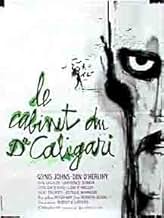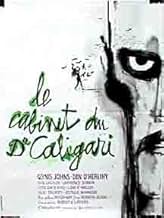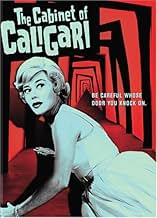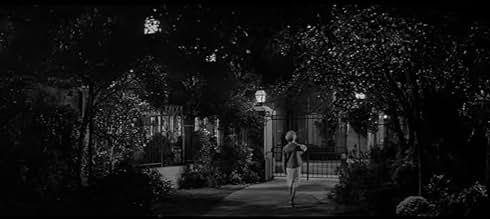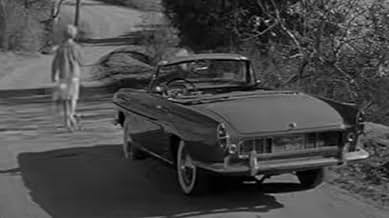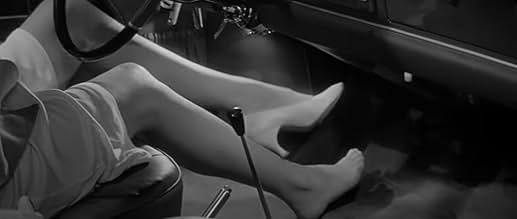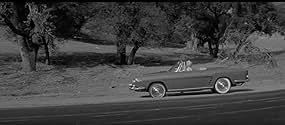CALIFICACIÓN DE IMDb
5.8/10
1.1 k
TU CALIFICACIÓN
Agrega una trama en tu idiomaA stranded young woman finds herself at a mysterious mansion where nothing is what it seems.A stranded young woman finds herself at a mysterious mansion where nothing is what it seems.A stranded young woman finds herself at a mysterious mansion where nothing is what it seems.
- Dirección
- Guionista
- Elenco
- Premios
- 1 premio ganado en total
Glynis Johns
- Jane
- (as Miss Glynis Johns)
Dan O'Herlihy
- Caligari
- (as Mr. Dan O'Herlihy)
- …
Richard Davalos
- Mark
- (as Dick Davalos)
- Dirección
- Guionista
- Todo el elenco y el equipo
- Producción, taquilla y más en IMDbPro
Opiniones destacadas
As was the case with many baby boomers, my first encounter with South African-born Glynis Johns, the daughter of renowned Welsh character actor Mervyn Johns, was via her short-lived American TV show, "Glynis." On this 1/2-hour sitcom, which only ran from September-December 1963 on CBS, Glynis played a character named Glynis Granville, a mystery writer who helped her husband solve crimes, and who was absolutely--to my young mind--delightful. A recent viewing of one of Glynis' later films, 1973's "Vault of Horror," served to remind me of just how charming she has always been, with her pretty blonde looks and inimitable husky voice. So it was with great eagerness that I even more recently popped one of her films that I'd never seen, "The Cabinet of Caligari," into the DVD player at home. Released in May 1962, five months before Glynis' 39th birthday, this "remake" of the classic German silent "The Cabinet of Dr. Caligari" (1919) jettisons most of the original's story line, salvaging only that famous twist ending. Scripted by Robert "Psycho" Bloch, the film introduces us to 27-year-old Jane Lindstrom (our Glynis), who seeks help at the ultramodern house of Dr. Caligari (Dan O'Herlihy) after her automobile suffers a blowout. The doctor is more than accommodating, but after she is unwittingly drugged, poor Jane realizes that she--and a good half dozen other residents under the doctor's roof--is a prisoner in this bizarre household, while Caligari's demands for highly personal information, as well as his peeping Tom proclivities, abuse of other "guests" and proffering of pornographic pictures, only add to Jane's distress....
Though lacking the surreal sets that made the original film an enduring and endearing classic of German Expressionism, the 1962 "Caligari" is still a fairly strange experience. Director Roger Kay utilizes interesting camera angles, freeze frames and occasionally non sequitur dialogue to engender an atmosphere of the macabre. Kay makes excellent use of space in his CinemaScope frame, and yes, DOES throw in some decidedly Expressionistic FX toward the film's conclusion. (I should perhaps add here that those viewers who choose to watch this DVD utilizing the "full-screen" option, rather than the "wide-screen," will be lacking almost 50% of the image, and will certainly be missing most of the picture's impact.) The director is ably abetted by the excellent camera work of John L. Russell, who had lensed "Psycho" for Hitchcock two years earlier (Jane Lindstrom, it might be added, has a bathtub experience in the film that is not QUITE as harrowing as Marion Crane's!), as well as by the lovely and memorable score provided here by Gerald Fried. But surely, this picture belongs to Glynis Johns, who perforce appears in every single scene in it. She is simply superb here, running the gamut from sweet to scared, haggard to Marilyn Monroe-type sexpot, suicidal and submissive to zesty and domineering; practically an Oscar-worthy performance! (And while I'm on the subject, hey, Academy: Glynis is 88 as of this writing. Howzabout an honorary Oscar for this wonderfully unique performer while she's still with us?) Perfectly cast here, she brings a combination of steely outrage and befuddled defenselessness to her role that is quite wonderful to behold, and makes the film--essentially a 100-minute-long red herring--a genuine must-see, and one that can stand independently of its famous forebear....
Though lacking the surreal sets that made the original film an enduring and endearing classic of German Expressionism, the 1962 "Caligari" is still a fairly strange experience. Director Roger Kay utilizes interesting camera angles, freeze frames and occasionally non sequitur dialogue to engender an atmosphere of the macabre. Kay makes excellent use of space in his CinemaScope frame, and yes, DOES throw in some decidedly Expressionistic FX toward the film's conclusion. (I should perhaps add here that those viewers who choose to watch this DVD utilizing the "full-screen" option, rather than the "wide-screen," will be lacking almost 50% of the image, and will certainly be missing most of the picture's impact.) The director is ably abetted by the excellent camera work of John L. Russell, who had lensed "Psycho" for Hitchcock two years earlier (Jane Lindstrom, it might be added, has a bathtub experience in the film that is not QUITE as harrowing as Marion Crane's!), as well as by the lovely and memorable score provided here by Gerald Fried. But surely, this picture belongs to Glynis Johns, who perforce appears in every single scene in it. She is simply superb here, running the gamut from sweet to scared, haggard to Marilyn Monroe-type sexpot, suicidal and submissive to zesty and domineering; practically an Oscar-worthy performance! (And while I'm on the subject, hey, Academy: Glynis is 88 as of this writing. Howzabout an honorary Oscar for this wonderfully unique performer while she's still with us?) Perfectly cast here, she brings a combination of steely outrage and befuddled defenselessness to her role that is quite wonderful to behold, and makes the film--essentially a 100-minute-long red herring--a genuine must-see, and one that can stand independently of its famous forebear....
This is one strange movie. It's been unavailable for a very long time and residing in something of a limbo until this welcome DVD release at an equally welcome low price. Basically, "The Cabinet of Caligari" has nothing to do with the famous 1919 silent movie expect for re-using the title, but is based on a thriller story written by the legendary Robert Bloch. It's hard to know how to describe this film, but comparing it to an extended episode of the Twilight Zone or the Outer Limits would be a good start - it has exactly the same stagy TV-like appearance, over wordy and deliberately obtuse script, and earnest (if rather hammy) performances.
The film starts with the heroine Jane (Glynis Johns) speeding blissfully along in a sports car, before coming to an unexpected halt due to a flat tyre. The motives or origins of this car journey are never explained, but don't worry, this is just the beginning of the disorientation that the movie is going to throw at you. Seeking help at a large house, Jane is welcomed inside and meets a handful of strange characters, all of whom appear helpful and pleasant. However, time passes and Jane begins to realise that she is being dissuaded from leaving, in fact she soon finds that it is actually impossible to leave the house and grounds. Presiding over the estate is a mysterious figure known as Caligari, who (with a hilarious hybrid accent) questions and confuses Jane, and generally menaces her in various ways. Jane begins to get more and more afraid as days go by, before losing control completely as the film's several shock twists start to kick in.
What to make of it all....? In a way, the film fails on a lot of levels due to the lack of realism of Jane's predicament. The casting of Glynis Johns as Jane works for me, as she has a very appealing vulnerability, but the script she is given really lets the character down. Jane never explains or expounds upon her feelings in the situation she is in, and therefore, some very obvious questions such as "Who are you all?" and "Why are you keeping me here?" never get asked or answered! Most of the time I was screaming at Jane to just confront her captors and demand some kind of explanation, but she simple drifts around the house engaging in rhetorical conversational ping-pong with the other "guests", with nearly everybody speaking in cryptic riddles like some low budget re-hash of "Last Year at Marienbad". But a lot of the situations she finds herself in are pretty odd, and there is a surreal quality about all the proceedings that works quite well, with some very unconventional filmic techniques thrown in at important moments. Although I couldn't shake the sense that Jane really wasn't trying that hard to get out of the place which did blow the mood somewhat.
However, having said all this, the final few minutes of the film contain the big twist that goes a long was to explain this very odd state of affairs...something which I cannot spoil for you here. I really regret that so many reviews of this film have given away the ending, as it must have been a very odd experience to watch it with no idea of the explanation...sadly I knew the ending in advance as well. But it does make for a worthwhile second run through of the whole film - if you can face another 100 mins of rambling nonsense and slightly whacky psychedelic effects - to see it in the light of what you learn at the end. The film is in black and white Cinemascope and looks gorgeous in full widescreen. The sets and imagery are pretty basic, but the cinematographer does what he can with selective lighting and weird angles.
To sum up, the film works best for fans of the two TV shows mentioned above. It's clever, but nowhere near as important as it thinks it is. I have to say though, that the DVD cover is a total knockout. You also get a full screen version to watch (don't - it ruins it) and a clunky trailer. Not bad for the price. A collector's curio.
The film starts with the heroine Jane (Glynis Johns) speeding blissfully along in a sports car, before coming to an unexpected halt due to a flat tyre. The motives or origins of this car journey are never explained, but don't worry, this is just the beginning of the disorientation that the movie is going to throw at you. Seeking help at a large house, Jane is welcomed inside and meets a handful of strange characters, all of whom appear helpful and pleasant. However, time passes and Jane begins to realise that she is being dissuaded from leaving, in fact she soon finds that it is actually impossible to leave the house and grounds. Presiding over the estate is a mysterious figure known as Caligari, who (with a hilarious hybrid accent) questions and confuses Jane, and generally menaces her in various ways. Jane begins to get more and more afraid as days go by, before losing control completely as the film's several shock twists start to kick in.
What to make of it all....? In a way, the film fails on a lot of levels due to the lack of realism of Jane's predicament. The casting of Glynis Johns as Jane works for me, as she has a very appealing vulnerability, but the script she is given really lets the character down. Jane never explains or expounds upon her feelings in the situation she is in, and therefore, some very obvious questions such as "Who are you all?" and "Why are you keeping me here?" never get asked or answered! Most of the time I was screaming at Jane to just confront her captors and demand some kind of explanation, but she simple drifts around the house engaging in rhetorical conversational ping-pong with the other "guests", with nearly everybody speaking in cryptic riddles like some low budget re-hash of "Last Year at Marienbad". But a lot of the situations she finds herself in are pretty odd, and there is a surreal quality about all the proceedings that works quite well, with some very unconventional filmic techniques thrown in at important moments. Although I couldn't shake the sense that Jane really wasn't trying that hard to get out of the place which did blow the mood somewhat.
However, having said all this, the final few minutes of the film contain the big twist that goes a long was to explain this very odd state of affairs...something which I cannot spoil for you here. I really regret that so many reviews of this film have given away the ending, as it must have been a very odd experience to watch it with no idea of the explanation...sadly I knew the ending in advance as well. But it does make for a worthwhile second run through of the whole film - if you can face another 100 mins of rambling nonsense and slightly whacky psychedelic effects - to see it in the light of what you learn at the end. The film is in black and white Cinemascope and looks gorgeous in full widescreen. The sets and imagery are pretty basic, but the cinematographer does what he can with selective lighting and weird angles.
To sum up, the film works best for fans of the two TV shows mentioned above. It's clever, but nowhere near as important as it thinks it is. I have to say though, that the DVD cover is a total knockout. You also get a full screen version to watch (don't - it ruins it) and a clunky trailer. Not bad for the price. A collector's curio.
I was an impressionable 17-year-old back in 1962 when CALIGARI shocked the living daylights out of me. And to this day -- though, naturally, to a far lesser (suspenseful) degree (and despite some of its obvious flaws) -- I can still sit through a performance of this haunting film in nearly rapt attention.
The main reasons for this are twofold: (1) The ever present youth in me can be easily summoned, so that contextually I am back in the early '60s, eager to reimmerse myself in the intensity of the dark psychodrama about to be played out, and blithely unencumbered by the need for (or expectation of) today's technologically superior special effects; and (2) Gerald Fried's ubiquitous, compelling film score music (especially the bittersweet main theme, played repeatedly in a multitude of beguiling variations) adds an immeasurable degree of enjoyment to this sadly underrated film.
Fortunately, the commercial-free Fox Movie Channel has featured THE CABINET OF CALIGARI, which has been, for the most part, unavailable for purchase by the general public.
The main reasons for this are twofold: (1) The ever present youth in me can be easily summoned, so that contextually I am back in the early '60s, eager to reimmerse myself in the intensity of the dark psychodrama about to be played out, and blithely unencumbered by the need for (or expectation of) today's technologically superior special effects; and (2) Gerald Fried's ubiquitous, compelling film score music (especially the bittersweet main theme, played repeatedly in a multitude of beguiling variations) adds an immeasurable degree of enjoyment to this sadly underrated film.
Fortunately, the commercial-free Fox Movie Channel has featured THE CABINET OF CALIGARI, which has been, for the most part, unavailable for purchase by the general public.
I had originally seen this movie at the age of fifteen; it continues to make a deep impression upon me. Though the plot does seem to move rather slowly by today's standards, it remains an amazing story of a young girl who has decided to come into touch with herself. Jane's validity depends upon her own understanding of reality versus fantasy. I am fortunate to have explored, through the DVD, the pleasures and horrors, as she leads the path that ultimately forces her to confront her inner fears. This "remake" may go beyond the original, but still exemplifies the importance of the caring and needs that we need to provide to our own. We are their caregivers. I was especially impressed by Constance Ford's role.
Jane Lindstrom is on vacation when her car gets a flat tire and she walks a long way before ending up at the house of Caligari who welcomes her in. After a strange night in the house, Jane feels uneasy around Caligari, as well as other people living in the house, so she asks to leave but she finds out that no one can help her to leave and she is unable to escape by herself. She finds a friend in Mark, a young man, as well as Paul, an intellectual man with a medical background. As Jane tries to break Caligari, she finds out that her attempts to free herself from the house and the spell of Caligari is becoming hopeless. This is not a remake of the 1919 classic, but does have the expressionistic elements of the original, as well as have its own feel with Jane's descent into madness. Johns gives one of her best and more complex performances and O'Herlihy is very spooky as the title character. Fried's musical score is used brilliantly in the film and is probably the best aspect of the movie. Bloch's script does have nice twists at the end, but is seems to go nowhere for the first hour of the film. Rating, 6.
¿Sabías que…?
- TriviaAlthough several horror/suspense movies (most notably Psycho) were advertised with the warning that patrons would not be seated after film began or during climactic final minutes, ads for this one included the unenforceable caveat that no one would be allowed to leave the theater during the last 13 minutes.
- ErroresAs Jane sits at the dinner table having a private discussion with Paul, the bowl of lobster bisque she refuses to eat disappears between shots.
- Citas
Caligari: How old were you when you first let a man make love to you? Next, who was he? Next, how did you feel at the time? Next, how did you feel afterwards? What did you feel? What did you think? Were you pleased, frightened, ecstatic, disgusted? What did he say? What words did you speak? That's what I want to know. Now. Tell me. Now. Now. All of it, now. Tell me. YES!
- ConexionesFeatured in Aweful Movies with Deadly Earnest: The Cabinet of Caligari (1973)
Selecciones populares
Inicia sesión para calificar y agrega a la lista de videos para obtener recomendaciones personalizadas
- How long is The Cabinet of Caligari?Con tecnología de Alexa
Detalles
- Tiempo de ejecución1 hora 46 minutos
- Color
- Relación de aspecto
- 2.35 : 1
Contribuir a esta página
Sugiere una edición o agrega el contenido que falta

